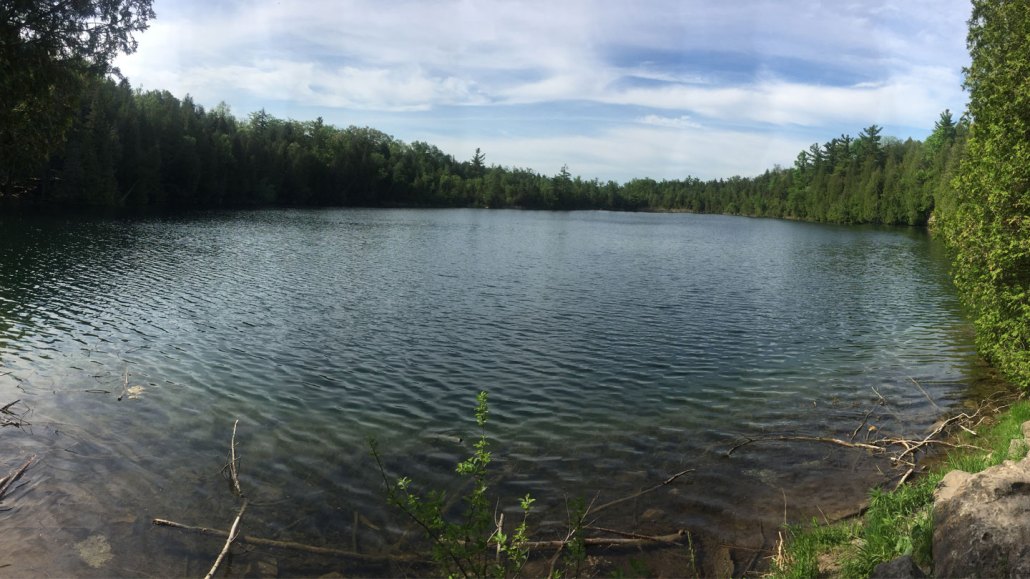
The mud of Canada’s Crawford Lake (shown) holds an extremely precise record of humans’ influence on Earth.
Sarah Roberts
- More than 2 years ago
Read another version of this article at Science News Explores
Scientists are one step closer to defining a new chapter in geology, one in which humans have become the dominant driver of Earth’s climate and environment.
Out of 12 locations around the world, Crawford Lake in Ontario, Canada, has been selected as the site that would mark the official beginning of the Anthropocene, a proposed geologic epoch starting in the 1950s, researchers announced at a July 11 news conference during the Max Planck Society Conference for a Sustainable Anthropocene in Berlin.
The lake bottom’s sediments hold one of the most precise records of humans’ alteration of Earth, including upticks in plutonium from nuclear weapons testing, ash from burning fossil fuels as well as heavy metals and microplastics.
But the Anthropocene isn’t an official geologic epoch yet. Now, several more committees must approve of the proposed epoch before it can be added to the geologic time scale. Doing so would end the nearly 12,000-year-old Holocene Epoch, which encompasses the rise of humankind since the last ice age.
Scientists first started using the term Anthropocene in the early 2000s to refer to the ongoing time of humans altering the planet on a global scale. Although framed in terms of geology, the Anthropocene lacked a formal geologic definition.
Still, the idea spread. “It exploded so quickly into other disciplines without it being defined,” says earth scientist Simon Turner of University College London. So “that’s what we’ve been trying to do ever since.”
In 2009, the International Commission on Stratigraphy, the scientific group responsible for defining geologic time, convened a committee to characterize the Anthropocene and see whether it deserved a spot on the geologic time scale. Over a decade later, that committee has now chosen Crawford Lake out of the 12 candidate sites as the Anthropocene’s “Global Boundary Stratotype Section and Point,” a reference site that shows a change in its rock, ice or other layers to mark the beginning of a new geologic time.
From coral to ice to peat, each of the candidate sites holds a remarkable record of human activity in its layers. Selecting Crawford Lake was “like choosing a favorite child,” says Turner, secretary and a voting member of the committee.
Among the locations, Crawford Lake’s muddy layers have trapped one of the most precise histories of human activity. Each summer, the water’s pH and warm temperatures cause mineral crystals to form near the top of the water. The crystals fall to the lake’s bottom like snow, where they lay undisturbed. “You get these lovely stripes,” Turner says. “And you can resolve what year [they’re from] pretty much by counting backwards from the surface layer, like a tree ring.”
The layers capture a sharp rise in radioactivity and other evidence of human activity starting in the early 1950s (SN: 9/25/16).
But not all scientists agree that the Anthropocene began merely 70 years ago, or that it should be defined as a geologic term at all. “Any time you draw a hard line in the geologic record or in any other system, you’re creating a binary — there’s a before and there’s an after,” says paleoecologist Jacquelyn Gill of the University of Maine in Orono. “We know human impacts began well before 1950.”
Retaining an informal and flexible concept, like what’s used now in disciplines beyond geology, might be more beneficial, she adds. “It’s more powerful as a tool in that way,” Gill says, “than it is to try to confine it or constrain it to a narrow definition that then creates confusion about everything that came before.”
Still, attempting to define the Anthropocene in geologic terms underscores humanity’s rapid and intense impact on the planet, Turner says. “We’ve become a geological force.”







